| In America, amongst people with an interest in the American War of Independence, Casimir Pulaski is believed to be surrounded by mystique. There is truth to this perception. First of all there is confusion about his date of birth. 6th March, 1747 is commonly attributed as Pulaski’s correct date of birth. This date has remained transfixed in the American consciousness due to the annual celebrations of Pulaski day and the constant repetition of this date as his true birth date by the media. This date has withstood the numerous references from sources in Poland, particularly from Warka, city of Pulaski’s ancestral home. In 2012, The ‘Poles in America Foundation’ has produced a fold up PDF booklet with definitive proof that Pulaski correct location and date of birth was Warsaw, 6th March, 1745.
Pulaski Booklet
Previous studies by two independent researchers, Father Stanislaw Makarewicz pastor of St Stephens Church in Radom, Poland, and Wladyslaw Rudzinski, also showed that 6th March 1745 was Pulaski’s true birthdate, and Warsaw the correct location.
poles.org
Nevertheless, the misconception persists.
Back home, in Australia, we know first-hand how difficult it is to debunk false statements. Novelist Helen Heney’s fictional Kitty Kelley type of character assassination purporting to be a biography of Sir Paul Edmund Strzelecki has yet to be completely dispelled from the minds of people who are only looking for a brief overview of Strzelecki’s life. Despite the detailed and thoroughly documented, lifelong research of Lech Paszkowski, Heney’s fictional account is still found in the non-fiction shelves of libraries rather in the fiction section where it belongs. Knowing this, the mistakes regarding Pulaski’s birthdate made by American museums didn’t surprise me, however what did surprise me was that an official Polish Government dedication to Pulaski, at Fort Pulaski, made the same mistake and gives credence to the wrong birth date and errors like this help perpetuate the error.
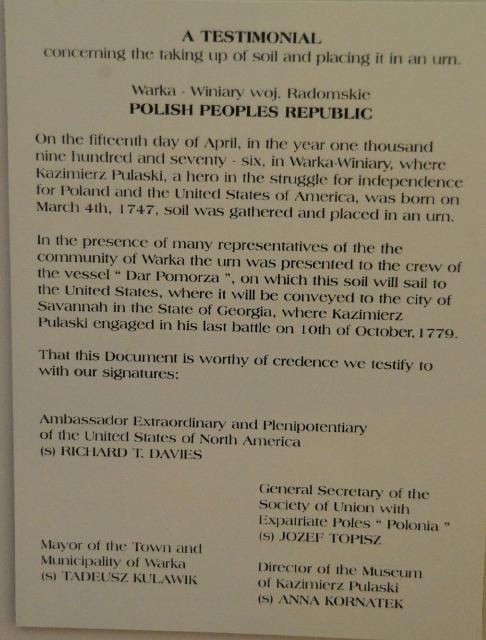
Birth Date Official Polish Government document exhibited at Fort Pulaski, Savannah Georgia USA incorrectly gives Pulaski's birth date as 4th March, 1747 and incorrectly locates the birth at Winiary Warka (English version) |
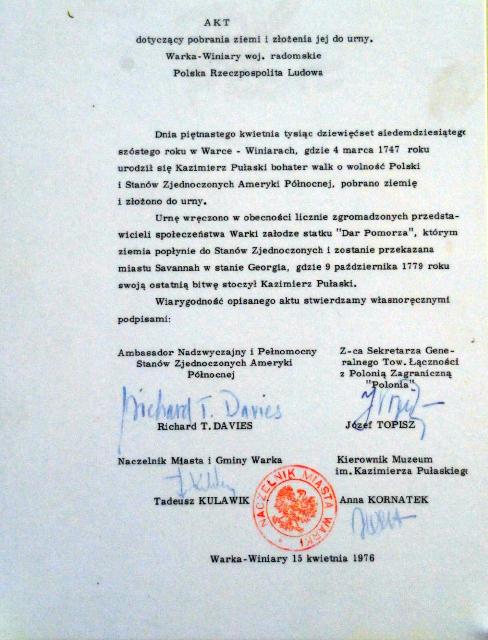
Same as 1, except in Polish and with official stamping |
A bigger mystery surrounds the circumstances of Pualaski’s death. It is generally believed, even today, that Pulaski died of his wounds while being evacuated on the American warship “The Wasp”, after which he was buried at sea. It is true that Pulaski died from the wound to his thigh inflicted by grapeshot from a British cannon when he was leading one of his famed ‘shock and awe’ charges on the British lines, but that is the only part of the statement that is true. Edward Pinkowski, founder of the Poles in America Foundation, similarly to the way Lech Paszkowski, dedicated much of his adult life to writing a truthful biography of Sir Paul Edmund Strzelecki, has dedicated his life to restoring to living memory and commemorating wherever possible the great deeds of the champions of liberty of Polish heritage, who contributed so much in the cause of American independence and freedom.
E. Pinkowski
Pinkowski’s lifelong research proved that Pulaski was buried on land with the exact site pinpointed after much detective work. He also discovered that when the Pulaski Monument in Monterey Square in Savannah, Georgia, was being constructed, Pulaski’s remains, draped in an American flag with remnants of his uniform, were disinterred and reburied under the newly constructed monument. Knowledge of this almost completely disappeared. Pinkowski tells the story of his detective work uncovering this mystery, compellingly.
www.poles.org/p_body.html
Edward’s son, Jack, a PHD in history, also gives a detailed account of the mysteries surrounding Pulaski’s death, published in English in ‘White Eagle’ (Bialy Orzel) and the Polish version, translated by Michal Kucharski.
www.poles.org/L_Kaz/E_Kaz.html
www.poles.org/L_Kaz/L_Kaz.html
When the monument in Monterey Square was being renovated in 1996, a metal casket, labelled Casimir Pulaski, was discovered under the statue. A forensic study of the skeleton matched exactly, in every way imaginable, Casimir Pulaski’s known stature, appearance and injury history from a long military career on horseback in Poland and America. Some have ignored the strength of this skeletal investigation as well as Pinkowski’s documentary support including eye witness accounts in correspondence he had unearthed after years of painstaking research. Some would only be fully convinced by DNA evidence.
Despite the discovery of relatives from which DNA could be sourced, the DNA from Pulaski’s remains had deteriorated to such an extent that it alone could not prove for certain that the remains under the Pulaski monument were in fact Pulaski’s. The quantity and strength of the non-DNA evidence is so overwhelming that it alone is enough to say with certainty that the remains that now lie buried beside the Pulaski Monument in Monterey Square, Savannah, Georgia, discovered in the metal casket labelled Casimir Pulaski when the monument was being renovated, are indeed of Pulaski.
The DNA investigation, however, did reveal yet another mystery surrounding Pulaski. Was Casimir Pulaski born a female, only to be turned into a male due to the malfunctioning of one gland with a resulting overproduction of male hormones by another gland? Pinkowski relates a fascinating account of this discovery.
In visiting markers, plaques, monuments and exhibits that honour Pulaski’s courage and role in helping America to win its independence from Britain which eventually led to the birth of a nation that has contributed so much to life as we know it in the US and around the world, I came across yet another mystery relating to Pulaski. Wiki had an account of Pulaski’s life and illustrated the text with a photo of the grapeshot that killed Pulaski that was extracted by Dr James Lynah. Wiki went on to state that the grapeshot is on exhibit in the Powder Museum of Charleston, South Carolina. Being in Savannah recently to view the Pulaski monument in Monterey Square I was only 2 hours drive away from the Powder Museum. Not wanting to go on a wild goose chase, I rang to be sure I would have something to see. They replied 'Yes, we have it on display'. I asked if visitors are allowed to photograph it. The reply: 'Yes they can'. I did the two hour drive there the next day, but the grapeshot I viewed on display is mounted differently, not on the expensive looking silver candlestick holder shown in Wiki, the one on display at the Powder Museum sits on a cheap plastic tube. The curator assured me that the research had been done, and indeed it was the grapeshot taken from Pulaski's thigh.
The next day, back in Savannah, I visited the Georgia Historical Society and saw the very grapeshot pictured in Wiki. The provenance for this exhibit is more certain as it is on loan to the Society from descendants of Dr James Lynah, the doctor who extracted the grapeshot from Pulaski's thigh. Letters documenting this fact are part of the Societies exhibit. When I told the Society of the Wiki reference to the Powder Museum and the fact that they too have grapeshot on display purportedly extracted from Pulaski. The officials at the Society were shocked because they were totally unaware of the Wiki reference or the fact there is grapeshot on exhibition in another museum anywhere. This immediately set the balls rolling for action to change the Wiki entry and the questioning of the provenance of the Powder Museum grapeshot exhibit. Only a few days after interacting with officials of the Georgia Historical Society I notice the Wiki entry has been corrected. If only the false references about Sir Paul Edmund Strzelecki could be amended so quickly and easily in Australia. We can only dream. I notice also that Wiki confirms that Pulaski’s body was carried from the battlefield by Colonel John C Cooper, forebear of Merian C Cooper who modelled his life on Pulaski and who established the Kosciuszko Squadron in 1919 that helped Poland defeat the Bolsheviks in the Miracle of the Vistula.
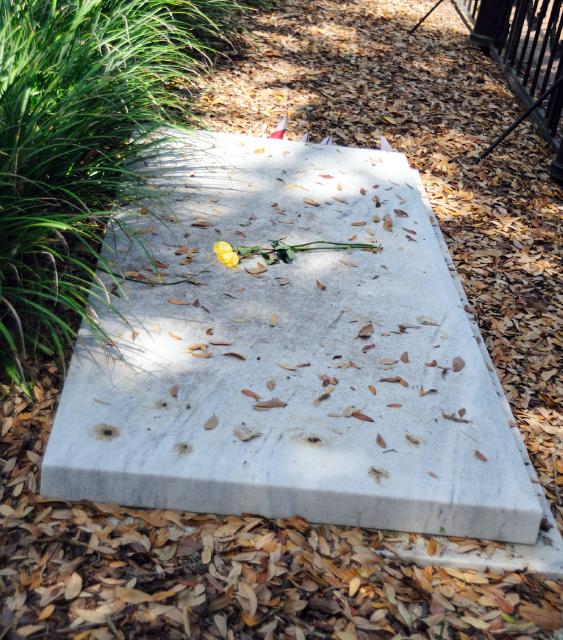
|
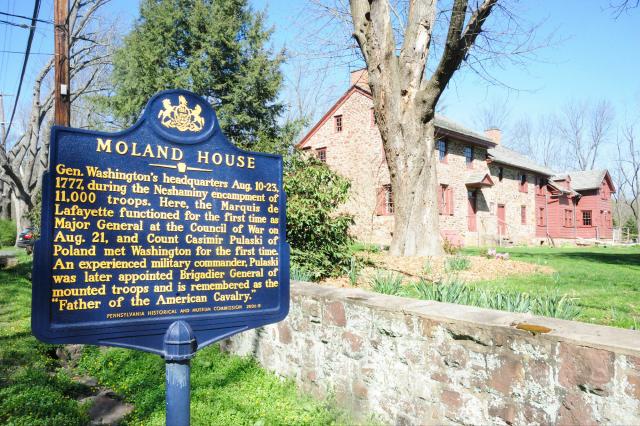
|

|
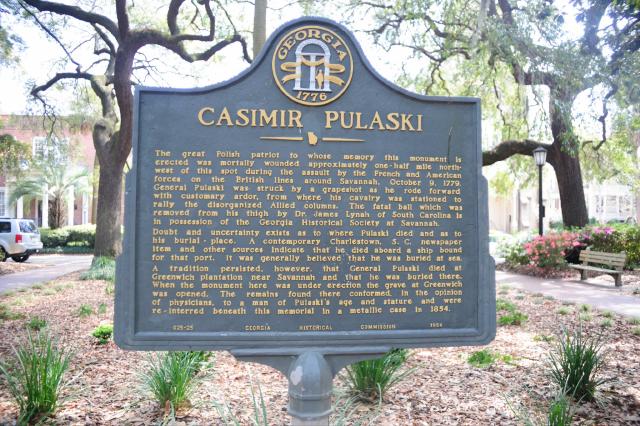
|
Here is the wiki entry as it is now:
en.wikipedia.org/wiki/Casimir_Pulaski
The relevant section after the change reads:
“The grape shot is still on display today at The Georgia Historical Society in Savannah, GA.”
This website still has a copy of the wiki article before the change:
www.enotes.com/topic/Casimir_Pulaski
the relevant entry reads:
“The grape shot is still on display today at The Powder Magazine military museum in Charleston, SC.”
I feel sorry for the Powder Museum, because the docent there was very sympathetic and knowledgeable about Pulaski, and permitted photos. No photos were allowed by the Georgia Historical Society.
Felix Molski
Grapeshot - mass of small metal balls or slugs packed tightly into a canvas bag.[1] It was used both in land and naval warfare. When assembled, the balls resembled a cluster of grapes, hence the name. On firing, the balls spread out from the muzzle, giving an effect similar to a giant shotgun. From Wikipedia
| 

